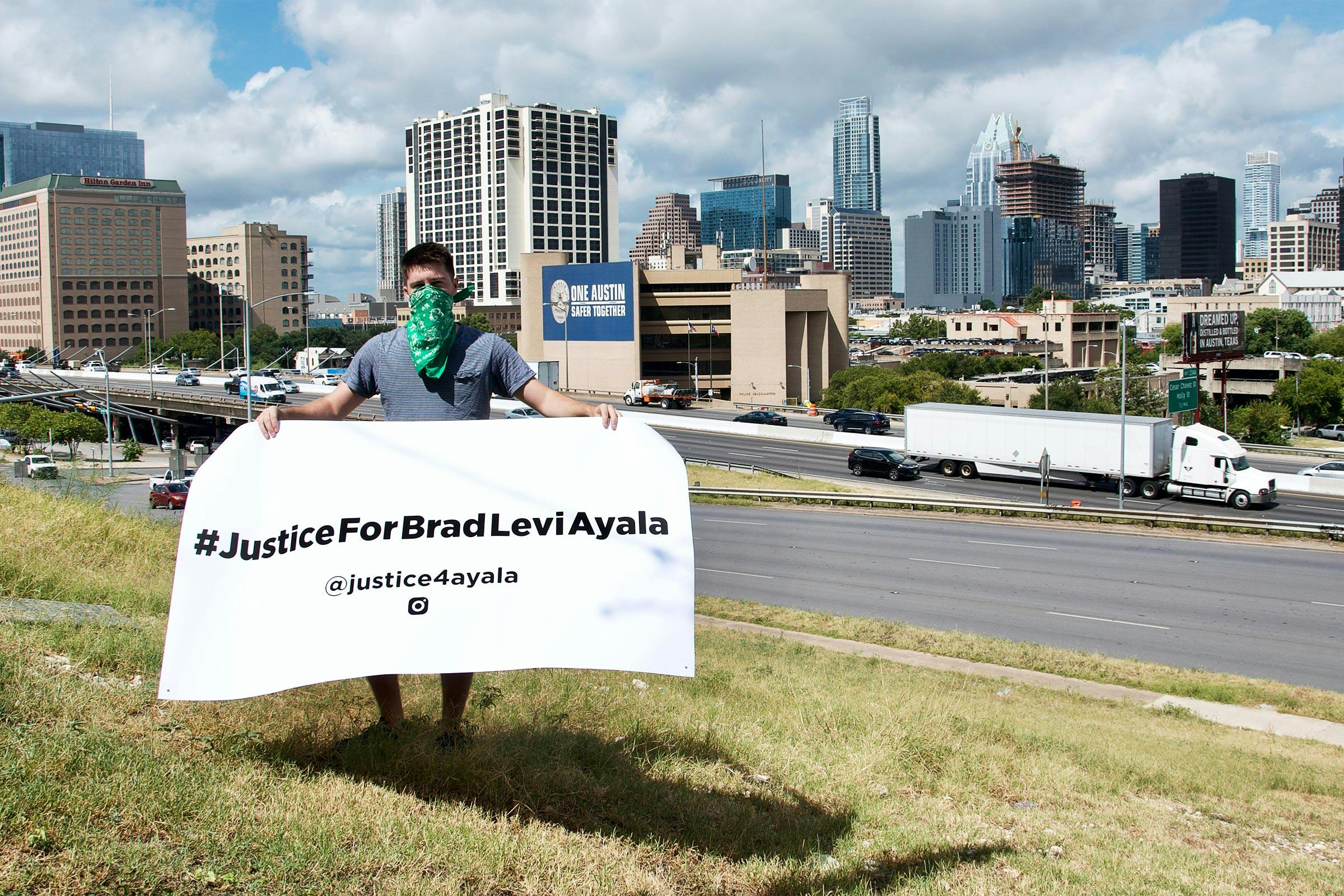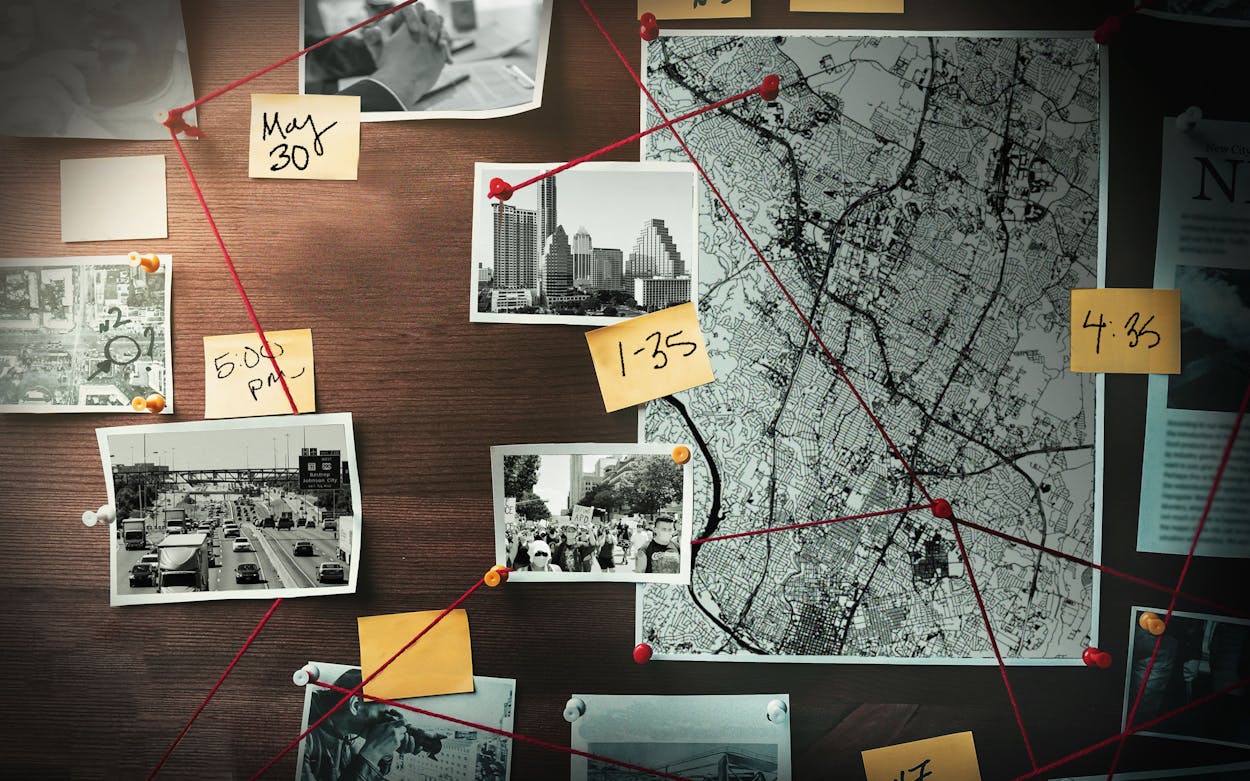By the time Brendan Walsh reached the top of the downtown Austin parking garage near the Texas Capitol, the blazing June sun was beating down and his short sleeve button-up shirt was covered in sweat. He took in the sweeping view, analyzing the overlapping arrangement of buildings, trees, and power lines before comparing the panorama before him with a screenshot from a video he’d saved on his phone.
Over the past few hours, he’d done the same at several other locations, without much success. This time seemed different. “This could be the spot,” he told me, pointing to a grassy hillside sandwiched between several office buildings about a half-mile in the distance. “From this angle, a camera would have a direct view of him when it happened.”
Walsh was referring to the Austin police shooting of sixteen-year-old Brad Levi Ayala with a beanbag round in late May, an incident captured by an unidentified camera, with an unknown operator, in a video clip that has gone viral. The grainy sequence, filmed from behind police, captures a key moment at the May 30 demonstration over the killing of George Floyd. An officer raises and fires a rifle moments before Ayala crumples to the ground, barely conscious and bleeding, a round lodged in his forehead. The teenager had been watching protesters from a hill overlooking the I-35 access road, about thirty yards from where the police were trying to clear the interstate.
It remains an indelible example of potentially deadly use of force by a police officer against a peaceful protester. Walsh, a finance expert at a tech startup with no formal investigative background, has spent much of the last month obsessively dissecting the clip with the help of a handful of online sleuths on an Instagram page called Justice4Ayala. At an emergency city council meeting several days after Ayala’s shooting, Walsh was surprised to learn that councilmembers still didn’t know the name of the teenager’s shooter. So he began vacuuming up as much video evidence as possible and posting it online in an aggressive pursuit of an ambitious goal: unmasking the officers who shot Levi Ayala and other badly injured protesters during chaotic protests in Austin. With the truth made public, he hoped the officers would be removed from the streets.
“I’m not the one to decide whether these individuals should get fired or charged, but at a very basic level they should not be walking around with a weapon of any kind ever again,” Walsh added. “That’s a public safety hazard for all of us.”
Nearly a month after Walsh began his investigation, Austin police released the names of five officers who had been placed on paid administrative duty, while a special investigations unit attempted to determine who exactly was involved in “protest-related incidents” during the first week of demonstrations. The department did not directly link any of the names to particular incidents, but the individual officers and their badge numbers matched information Walsh had gathered from his analysis of the Ayala video. For weeks, Walsh had been convinced the shooter was officer Nicholas Gebhart, a seven-year veteran of the force. He was right. “We can confirm that Officer Gebhart is the officer involved in this incident,” APD spokesperson Tara Long wrote in an email to Texas Monthly on July 29.
“The investigation into the incident is ongoing,” Long added in a separate email. “We will not know about any potential disciplinary action until that is concluded.”
Gebhart was also involved in a fatal shooting of an armed man in 2018. He was one of seven officers who fired their weapons during a vehicular chase following a carjacking. Afterward, he and his fellow officers were placed on administrative leave. Last year, Travis County district attorney Margaret Moore ruled that the officers were justified in their use of force.
Reached before APD confirmed the name of the officer, a spokesperson for Moore declined to comment, citing the ongoing investigation. Moore, or her likely successor, José Garza, will be tasked with deciding whether Gebhart’s actions represent a fleeting, tragic mistake or an unjustifiable use of force worthy of criminal prosecution.
As investigations into the Ayala shooting play out behind closed doors and neither police nor the district attorney’s office release more video evidence or information explaining why the teenager was shot, Walsh sees his efforts as a model for holding police accountable by keeping the public informed of their excesses. Neither Ayala’s family nor lawyers handling his case immediately responded to questions about whether they’re supportive of Walsh’s work. Several weeks after his brother was injured by police, Edwin Ayala, Levi’s older brother, thanked Walsh on Twitter and called his work “Amazing!”
Walsh believes that APD likely knew the individual’s identity in the first weeks, if not days, after the shooting. After all, he was able to identify Gebhart using little more than a laptop and deductive reasoning. Walsh said that although APD has confirmed that investigators know the name of the officer, nobody has yet been fired or suspended without pay. “The public is being kept in the dark on an issue that didn’t just affect one victim of police brutality, but many,” Walsh said.

For years now, smartphones have been used to document police brutality, usually one clip at a time. Walsh has never fashioned himself an activist of any kind, but his trust in authorities has been eroded by years of damning videos undermining official police accounts. In particular, his skepticism was galvanized when evidence, forcibly made public by court order, revealed that police officers in his hometown, Chicago, who had shot and killed seventeen-year-old Laquan McDonald, had repeatedly lied about his behavior in the incident.
Walsh’s current efforts represent something potentially powerful: an attempt to aggregate individual clips captured on hundreds of phones and cameras and turn them into a digestible story that can be widely disseminated to the public via social media.
Walsh maintains that he’s not affiliated with any local groups fighting for police reform in town, describing each group’s work as supportive “links in a chain.” So far, his Instagram page has one video of the incident, and dozens of screenshots from videos of the moments before and after the Ayala shooting. Together they present a detailed, if individually incomplete, chronology of what happened from seven different angles.
Most of the clips Walsh has watched begin as dozens of officers advance toward protesters on I-35 in a regimented fashion, beating some, gassing others, and firing a volley of beanbag rounds, so loud that some observers filming the scene from nearby apartment buildings mistook the munitions for live gunfire. Protesters fall to the ground. Demonstrators scream for medics. The injured are dragged away by police or carried to safety by strangers. Some images appear to show officers smiling as their colleagues fire upon demonstrators.
“It was warfare being conducted on Austin citizens,” Walsh said, rewatching the videos.
Ayala appears in only one video: he’s captured on a stationary camera far behind police officers. Early on, much of Walsh’s effort was focused on this viral video clip. If he could locate the mysterious source, he reasoned, he could get his hands on a longer sequence with definitive clues as to which officer had shot Ayala. Though obtaining the original clip remains an important goal, Walsh realized the edited version might yield clues, at least when cross-referenced with the flood of other footage posted on YouTube and Instagram by demonstrators.
The regimented nature of the officers’ movements meant that police rarely switched positions, making it easy to compare clues from the viral video to other images and videos taken from different angles, some of them by daring protesters who recorded police from only a short distance away. A few key insights emerged. In the viral video, not all officers were holding rifles, and they were of varying heights. Among the row of police, Gebhart is one of only two officers with the plastic visor on his or her helmet raised. Footage shot from the front, including a graphic video taken seconds after by demonstrators who surrounded a collapsed Ayala, shows as many as twenty officers, but only two have raised visors.
Once Walsh was confident he’d identified the alleged shooter from the front, he was able to zoom in on several video images captured by protesters and journalists at the scene that revealed at least four letters of the individual’s last name and several digits of his badge number.
When APD released the names of the suspended officers under investigation last month, the letters and numbers matched perfectly with one of the officers on the department’s list—Gebhart. In the days before the department confirmed the shooter’s name, Walsh said he was in the process of interviewing witnesses and trying to track down more footage connected to the Ayala shooting. He was waiting on definitive proof to turn over to city officials and the DA’s office.
Though Walsh’s sleuthing proved correct in the Ayala case, critics warn that such efforts risk exposing innocent officers to an unwarranted public backlash and placing undue pressure on public officials overseeing carefully executed investigations. Despite its proliferation, video evidence still proves unreliable in many cases. Last year, Detroit wrongfully arrested a Black man using flawed facial recognition technology, according to the New York Times. Years earlier, online sleuthing on Reddit led to two men being mistakenly identified as suspects in the Boston bombing case and having their images appear on the cover of the New York Post under the headline “Bag Men.”
“Just as we’ve seen unfortunately over the years where police have misidentified a suspect and it’s the wrong person, there’s also a chance of the public doing the same thing just from circulating a video,” said Mickey Osterreicher, general counsel of the National Press Photographers Association, who has spent years training police to understand the public’s First Amendment right to film them. “There are serious consequences to people deciding to take the law into their own hands to address a grievance. You need to do things the proper way.”
Asked how he’d respond to critics who argue his work borders on vigilantism, Walsh said he posts analyses of video on Instagram with extreme caution, and never with retribution in mind. His posts, he argued, aren’t sensational but detailed, if not altogether dull at times. He also said he wouldn’t be forced to compile photographic evidence if police operated with more transparency.
“We’ve cooperated with police on body camera experiments—they turn them off,” he said. “We hear footage was available for police force and shootings, except it was destroyed. Video evidence gets turned in and sits with DAs for months, even years, while the public demands to see it.”
Last week, APD announced plans to delay the release of “critical incident” videos—which can range from body-camera feeds to footage taken by third parties and from APD’s Air Support Unit—that captured officers who caused serious injury to protesters.
“Meanwhile,” Walsh added, “the world-changing movement around George Floyd that rocked Minneapolis and the world came from three public citizen’s cellphone videos.”
- More About:
- George Floyd
- Austin








